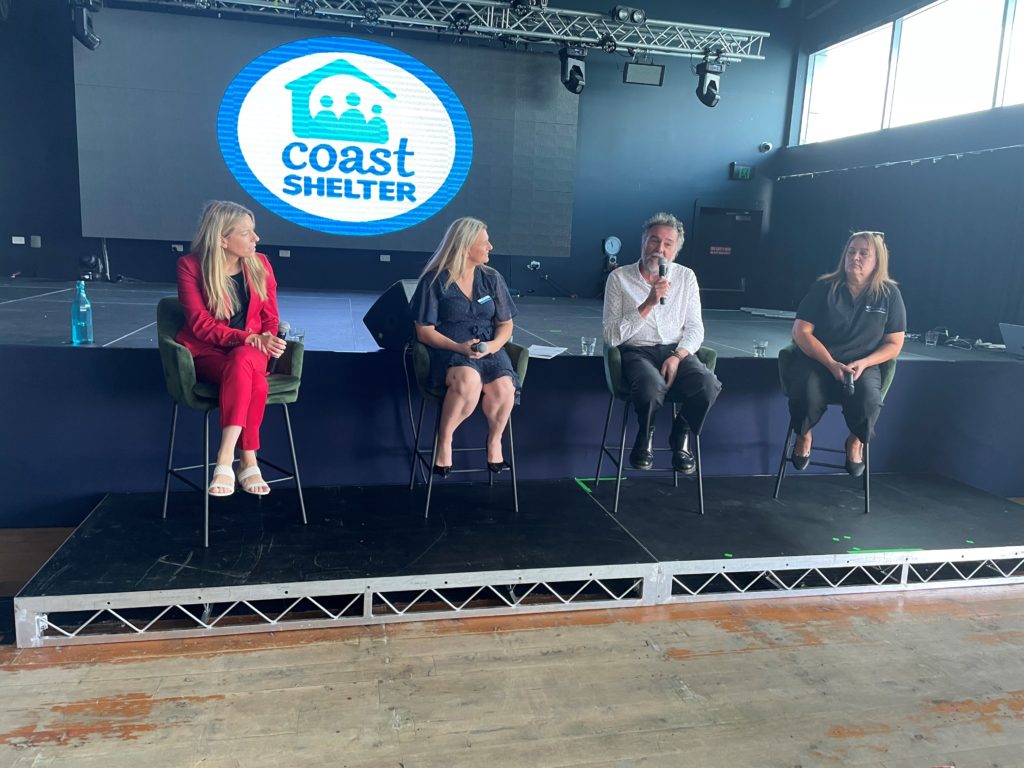With housing shortages and homeless on the Central Coast likely to be a big election issue on March 25, Member for Terrigal Adam Crouch and Member for Gosford Liesl Tesch outlined their governments’ policies at a symposium in Gosford on March 10.
Despite several commitments from Tesch to address the crisis and a generalised statement from Crouch, neither candidate promised the cold hard cash homelessness services say is needed to address the situation.
Organised by Coast Shelter and Homelessness NSW, the symposium also featured a panel discussion featuring representatives from Catholic Care, Central Coast Council, Bungree Aboriginal Association and Homelessness NSW.
Coast Shelter CEO Michael Starr kicked off the symposium, saying demand for temporary housing through the organisation was outstripping capacity, particularly for young people aged under 25, with a steady increase in demand every month for the past year.
He said priorities for a new State Government should be appointing a Minister for Housing and Homelessness and establishing one lead agency to co-ordinate housing relief.
“Separate responsibilities don’t work,” he said.
“We also need an integrated response from all levels of government.
“Fragmented responses are not acceptable – services need certainty.”
Homelessness NSW CEO Trina Jones spoke next, telling the symposium current rates of homelessness, exacerbated by COVID-19 and the rising cost of living, were solvable with concerted government action.
“In 2021, 70,000 people were assisted out of homelessness – 30 percent more than support organisations are funded for,” she said.
“Almost half (48 percent) of those asking for help had to be turned away.
“We are the second lowest funded state or territory in the country but have the second highest incidence of homelessness behind the Northern Territory.”
Jones said with 57,000 on the waiting list for social housing and many waiting up to 10 years for placement, it would take 80 years just to house those currently on the list.
She called for a new benchmark of 10 percent of all new housing to be social housing by 2050 and for an additional State Government investment of $1.279B to attack the crisis, along with an extra $152M each year for homelessness services.
During the panel discussion, Bungree Manager Homelessness Services Miley Nixon said lack of housing stock was seeing the service turn many away, with support offered only to the most vulnerable.
Central Coast Council Unit Manager Community and Culture Glenn Cannard said the Council was committed to a forward-thinking strategy to address the problem, with access to suitable land for housing one of the major issues.
Angela Whitby of Catholic Care said the service was also seeing increased demand, with an associated spike in domestic violence forcing a response reaction rather than prevention.

Tesch addressed the symposium next, acknowledging that government needed to do better, with 60-80 percent of those seeking help from her office experiencing housing stress, and women the most vulnerable.
She said Labor knew it was time to stop “buck passing” and already had a Shadow Minister for Housing and Homelessness, with a Minister in a new Labor government to be responsible for the sector.
She said Labor had plans to: introduce five-year funding blocks for service providers to create certainty; free-up more government land for housing; double funding for women’s health centres and increase support to Lifeline for face-to- face services; and foster a whole-of-government approach to suicide prevention.
She pointed to a recent pledge of $20M for specialised mental health housing on the Coast to ease the strain on regular homelessness services and said she would be personally pushing for $5M for Pacific Link Housing and more housing for young people other than stand-alone houses.
“It’s time to start looking at out-of-the box solutions such as Allawah House at East Gosford,” she said.
That project saw a disused aged facility converted into a 14-room transitional housing facility for displaced older women.
Tesch said Labor had committed to the 10 percent of housing to be social housing by 2050 benchmark.
Crouch took the podium next, saying finding housing solutions was “not an easy fix” and praised Central Coast Council for “thinking outside the box” and working closely with Pacific Link Housing.
He said one of the biggest blocks to releasing land for social housing projects was opposition from the community.
“There is the opportunity to unlock land for thousands of homes in our region – the Pacific Link development in Beane St, Gosford is a good example – but we need to remove bureaucratic barriers,” he said.
“Every time we see an application for a boarding house or social housing development we hear opposition – and that holds up these projects for 6-12 months, which is denying people the right to have a roof over their heads.”
Neither MP made mention of Homelessness NSW’s plea for a $1.279B commitment to attack the housing crisis and an extra $152M each year for homelessness services.
Terry Collins




There should be incentives provided to homeowners either by state, federal or local govt that encourages them to build tiny houses or granny flats on spare ground in their back yards. These tiny homes or granny flats can then be managed by social housing groups, that can be then make these available for long term social housing. A social charter exist between the homeowner, social housing organisation and the individual seeking accommodation.
The home owner would be compensated with a recovery of the overall construction costs and insurances either through tax concessions or paid an amount that is included into the weekly rental charge.
With housing shortages and homeless on the Central Coast its not only the Central Coast that is hurting it is Everywhere yes everywhere and I would have to say that it needs to be addressed as a Priority